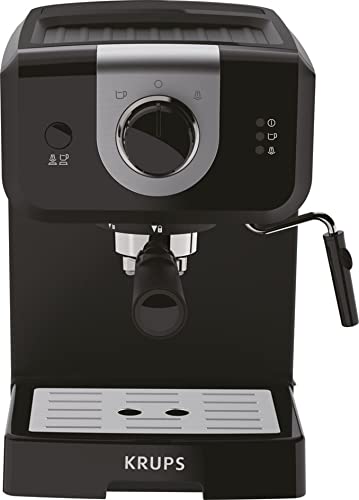온 · 습도센서 Who Is Espresso Machine Coffee And Why You Should Take A Look
페이지 정보

본문
 How to Make Espresso Machine Coffee
How to Make Espresso Machine CoffeeEspresso machines can produce an excellent cup of coffee, but they require more maintenance and setup than a standard coffee maker. You'll also need to grind and tamp the beans yourself.
The key to making espresso is pressure. How an espresso machine works is that heating vessels heat the water to the ideal temperature, then it forces it out of the spouts and into the grounds.
Temperature
Espresso is produced by forcing hot water through finely ground coffee. The temperature of water is essential to the final shot. Insufficient temperatures cause lack of flavor compounds. High temperatures cause over extraction, which can cause a bitter or burnt taste.
The ideal temperature for espresso is between 195 and 205degF. This temperature can be achieved by using the group head, which is designed to ensure stability and a consistent temperature throughout the brewing process. The most popular kind of group head is the E61 that offers a combination of temperature stability as well as pre-infusion capabilities and lever control.
When adjusting the espresso machine for different roasts and brew ratios it is crucial to take into consideration the effect of temperature on extraction yield as well as crema. The ideal temperature will vary depending on the roast and bean. However the general rule is that lighter roasts with higher brew rates require higher temperatures. A reliable thermocouple is vital to maintain a constant temperature.
Pressure
In the process of brewing, Travel Espresso Maker machine coffee is pressure-pushed through finely ground and tamped grounds. This causes chemical reactions which extract flavors, oils and other soluble components. The resulting drink is usually more flavorful and richer than regular coffee.
The ideal espresso machine sale machine's pressure is nine bars of pressure which is equal to the atmospheric pressure at sea level. The soluble compounds in the espresso bean can be best extracted at this pressure.
Some espresso machines advertise up to 20 bars of pressure. Although these machines can achieve these levels of pressure however, they may not be in a position to maintain the pressure during the extraction.
To put that into perspective, one bar of pressure is equivalent to 32 pounds per square inch PSI of the tire of a car. It's four times the pressure a professional cyclist uses when filling their bicycle tires. The ability to control espresso machine's pressure, and to make consistent espressos is the key to any serious barista at home.
Water
The water you use in your espresso maker is among the most important aspects of a great cup of coffee. The right water can help your beans extract their full potential. However, the wrong water could cause issues like clogged pipes, or even damage to your expensive espresso machine.
To get the most espresso extraction it is recommended to choose the natural spring that has a high mineral content. This water will elevate the flavor of your espresso without the chalky mineral trace that comes from tap water or bottled water. This is a great alternative to distilled water or reverse osmosis, which can be too filtered and cause taste issues.
However, you should never use an water filter that removes too many minerals from your tap water, as this can also cause flavor and extraction issues. Get a water test kit to determine the average hardness of your local water. This can then be used to find the best filtration system to provide the right water requirements for your espresso machine.
Beans
The majority of coffee enthusiasts be very involved in the whole process of making espresso. They ponder a myriad of variables, such as temperature, pressure of water beans, milk viscosity and other aspects. If one variable is off even slightly, the entire shot could taste bad.
The beans used are the most important aspect when it comes down to espresso. Many people believe that only certain types of beans are suitable for espresso. Although certain beans are suitable for travel Espresso maker certain uses, any roasted coffee bean can be used to make espresso. Espresso beans are roasted for longer than regular coffee beans, which is over the second crack. This gives them a darker look and makes them more water-soluble.
The best espresso beans are usually medium-roasted or dark roasted. This gives the espressos their distinctive richness and vigor. Light roasted beans can also be used to make fantastic espresso, particularly when they are ground prior to use to make it easier to use an espresso coffee maker maker.
Milk
Espresso and milk are a classic pairing. The combination of espresso and milk is the most popular. Not only does it increase energy but it also balances the bitterness of espresso. This is one of the best pairings for a meal!
When you are choosing an espresso machine capable of making latte or the cappuccino as well it is important to consider how easy it is to use. The best espresso machines come with a jug of hot or cold milk and a steam wand. They also come with a portafilter for pulling the shot. Certain models have an integrated grinder, tamper and frother.
The steam wand should be cleaned prior to using it for the first time each day (or after each cup of espresso) to clear out any water that has condensed. This process is only 30 seconds, but it's vital to keep your machine running smoothly. Failure to cleanse could result in bitter taste or a build-up of bacteria which can alter the flavor and smell of your beverages. It's easy to do and should form part of your routine maintenance schedule.
- 이전글The Top Reasons Why People Succeed In The Best Espresso Machine Industry 24.04.29
- 다음글You'll Never Be Able To Figure Out This Window Replacement Near Me's Secrets 24.04.29
댓글목록
등록된 댓글이 없습니다.
